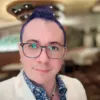Feature: Agar Art with Sarah Jeanne Adkins
Drawing with bacteria? This is a super cool art technique called Agar Art, and I’m entranced by it! There’s a lot of nuance and unpredictable elements to that are both terrifying and exciting to me as an artist. Luckily, we have Sarah Adkins, microbiologist and SciArt-ist, who is an NSF Graduate Research Fellow using Agar Art for biology education.
Sarah has previously joined us in our SciArt Livestream, where we talked about non-traditional art techniques (and a lot of other things). I definitely recommend checking that out because I had a great time chatting with her!
View her work and follow her progress on Twitter and Instagram.
Q: Please introduce yourself to the audience.
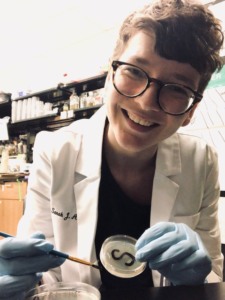
My name is Sarah Adkins. I’ve managed to make it — along with the millions of bacteria on me along for the ride — to my fourth year as a Biology PhD Candidate at the University of Alabama at Birmingham. I study ways to improve biology education through evidence-based practices as well as do basic research in microbial ecology.
Q: Tell me about the balance of art and science in your life. How do you feed both passions?
As a scientist, I pretty much know when I’ve done something right, like a band on a gel will appear indicating the presence of DNA.
As an artist, this feeling of completion is much more nebulous, where it’s up to me to decide when something is right or complete. I have the great liberty to bounce back and forth between these frustrations in a way that ultimately fuels my interest in both realms.
When I’m frustrated at my science, I find freedom in my art. They intersect in smaller ways, too — I find myself drawing out my science methods using chalk pen on my bench, the fridge, my desk…
Q: What is your favorite part of making Agar Art?
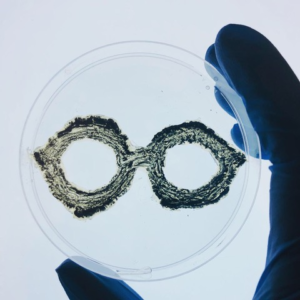
My favorite part of Agar Art is helping to teach it. I enjoy the child-like amazement people have when they compare their intentions to the microbes realities. Pointing out bacterial warfare, like antibiotics, is especially exciting, especially when people make connections that antibiotics are bacterial chemicals, rather than a man made invention.
A superb example of antibiotics in action can be shown on “The battle of winter and spring” plate by the 2018 ASM Agar Art Contest 1st Place Winner, Ana Tsitsishvili. Agar Art is more than an art, it’s a breeding ground for discovery in science.
Q: What’s the most important skill you’ve gained in your life of science & art?
I remember this feeling of almost existential doom preparing for my qualifying exams for graduate candidacy. I was reading books like Modell’s “Imagination and the Meaningful Brain”, Calvin’s “A brief history of the mind”, Wilson’s “Consilience”, and Singlerand’s “What Science Offers the Humanities”.
Sure, there was the idea of inadequacy and imposter syndrome that looms over most graduate students, but this feeling struck an even deeper chord for me. I was confronting the philosophical differences between science and art. Could all of the universe’s complexities, like artistic expression, be reduced to scientific facts?
Realizing that people have fundamentally different perspectives on how and why the universe is constructed, and thinking through these ideas myself, is an important concept I’m still growing with.
Q: What advice do you have for someone who wants to make their own Agar Art?
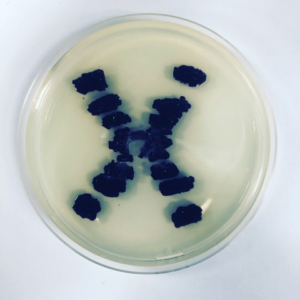
If you want to paint using bacteria, it’s simple to get started!
If you have access to a microbiology lab, it’s fairly easy to get your hands on the media, utensils (toothpicks, cotton swabs, loops, or paintbrushes), and colorful bacteria (or dig up your own!– see our lab manual) If this is your route, ASM has made a great instructional video you can watch here. Barring that, I highly recommend Amino Labs — for use in a home, they have safe do-it-yourself agar art kits for $38.
Like traditional visual, art, it’s important to have a vision before you get started. But unlike traditional art, you’re using living organisms so it may come out different than you expect! This, I’ve come to realize, is where the real learning begins!
Q: What’s the most interesting/weird fact about Agar Art?
The discoverer of the first clinically relevant antibiotic, penicillin*, back in the 40’s was also one of the first pioneers of agar art. How amazing was it that Sir Alexander Fleming’s attention to detail through art could have led to the world-changing discovery of antibiotics? I explore this more in the August 2018 issue of Sci Art Magazine, so if you subscribe to them, check it out!
*Penicillin was actually discovered years prior by Ernest Duchesne but apparently nobody reads graduate dissertations….
Q: What else do you definitely want the audience to know about Agar Art?
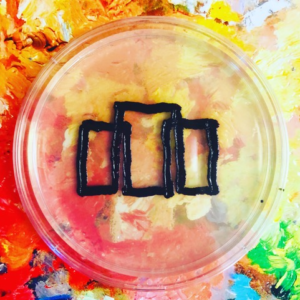
From the oxygen we breathe to the antibiotics we take, bacteria and other microbes are essential for life on Earth. But as Mark Martin and other science educators help us to realize, microbes don’t always have a good reputation. For that reason, agar art can a high-impact way to engage the public in the fascinating worlds microbes create. And this rings close to home — my mom, who hasn’t been around science classes in decades — told me she struck up a conversation with her podiatrist about bacteria following Agar Art in the news.
It has an even greater potential in the classroom. Earlier I referenced Ana’s winning plate. When you look at her plate, you see pigment inhibition. This leads students to ask “Why?” “What’s going on?” My advisor (Dr. Jeff Morris) and I built a class around these questions (Click here for syllabus or here for lab manual) , where students create their own experiments to ask their own questions from the interactions they see on their Agar Art plates.
Q: Where can the audience find out more about you and your work?
We’ve published the results of our Agar Art curriculum which you can find in the latest thematic issue of FEMS Microbiology Letters or in an Oxford University Press summary.
To find out more about the American Society for Microbiology (ASM) Agar Art contest, which piqued our interest in using Agar Art as an education tool back in 2015, visit their website. You can also check out the work of Dr. Mark Martin (who Tweets at @markowenmartin) with Dr. Jennifer Quinn, as well as Dr. Hunter Cole who have majorly popularized Lux Art, Agar Art which uses bioluminescent bacteria. This field is ever-expanding and I am very grateful to meet some of the biggest names .





